Project Introduction
Port3 Network is an all-in-one social application project that aims to create, leverage, and develop Web3 identities by aggregating and standardizing off-chain/on-chain data, building a social data layer.
The SoQuest platform of Port3 Network is one of the widely targeted Web3 Quest platforms, helping projects establish a Web3 community and aggregate various project activities and information. Project teams can initiate activities to attract user participation, and users can earn rewards while participating in these activities. Additionally, Port3 has established an interconnected suite of products, including Robot Matrix, SoQuest task platform, SoGraph analysis platform, etc., with the goal of helping users bridge the gap with Web2 and accelerate the transition to Web3.
Author
Elma Ruan, a senior research analyst at WorldChain Investment Research, holds dual master's degrees in marketing/finance from an Ivy League school and has 5 years of experience in Web3, specializing in DeFi, NFT, and other areas. Before entering the crypto industry, she worked as an investment manager at a large securities firm.
1. Research Focus
1.1 Core Investment Logic
In recent years, the Web3 space has rapidly emerged, but it has also revealed a series of common problems:
Strong demand for Web3 project growth: Web3 projects require strong growth strategies to attract more users, but there is currently no mature Go-to-Market (GTM) methodology, especially with differences from traditional Web2 growth hacking methods, making many traditional marketing tactics less applicable.
High entry barriers for Web2 users: For Web2 users, entering Web3 requires overcoming certain technical and conceptual barriers, which has become a major obstacle to user influx.
High proportion of loss in traffic distribution: During traffic distribution, Web3 projects face a high user churn rate, posing a challenge to project growth.
Lack of native growth tools for Web3: Currently, there is a lack of native growth tools for Web3, making project growth somewhat challenging.
Lack of refined operation for Web3 projects: The lack of refined operation for Web3 projects, including data analysis, limits the continuous development of projects.
Port3 Network focuses on building a Web3 social data infrastructure project, addressing the above-mentioned issues in Web3 by providing an all-in-one social base layer and corresponding application layer services to support various aspects of Web3 development. Its business scope covers comprehensive social data analysis and application services, Bot application services, Web3 task and mining ecosystem, and comprehensive social data analysis and insight platform.
Port3 Network's community management function is very powerful. Utilizing the SoQuest platform, it can help project teams establish and manage an active, orderly community, promptly respond to user issues and needs, and enhance user satisfaction and trust. Through effective community operations, projects can retain more loyal users, laying a solid foundation for long-term development.
Furthermore, with its strong user acquisition capabilities, Port3 Network has rapidly attracted a large number of potential users. Its unique Ask Me Anything (AMA) feature (assisted by bots) allows project teams to engage in direct, in-depth interaction with users, significantly increasing user engagement and stickiness. In addition, Port3 Network also provides various social media integrations such as TG Bot and Discord Bot, providing extensive exposure channels for projects, further expanding the user base. These bots also support functions such as information reminders, reward distribution, and data analysis. Information reminder function can assist projects in timely pushing important information to users, maintaining user attention. Currently, the yet-to-be-implemented data analysis will become a key optimization strategy for the project. If it can truly establish a connection between the Web2 and Web3 social data layers, it will have built a solid infrastructure for the entire SocialFi field. This will enable in-depth analysis of user behavior data and provide an all-in-one platform service, marking a crucial step towards transitioning from Web2 to Web3 in a true sense.
However, it is worth considering that while projects proposing solutions to the existing problems in Web3 are emerging, Web3 has not yet formed a complete growth methodology, and growth is still in a relatively blind stage. Whether in Web2 or Web3, customer acquisition, activation, retention, and referral remain the core logic and process of social track growth. In Web3, many common methods for customer acquisition, such as AMA and Giveaway, have emerged, providing multiple possibilities for projects to acquire customers. With the continuous development of the ecosystem, the number of projects continues to increase, giving rise to numerous DApps focusing on user acquisition, community management, information reminders, reward distribution, data analysis, and other multidimensional aspects. These tools enrich the possibilities for growth but also bring about overlap between projects. In the future, the development direction of these projects will inevitably move towards refined operation, growth strategies, or towards the direction of all-in-one platform services. Regardless of the chosen direction, the ability to relatively accurately retain loyal seed users will become crucial.
Specifically, Port3 Network performs well in terms of user overlap, but this also means that its market positioning and user attractiveness may be similar to other platforms, especially with a high degree of overlap with Galxe users, possibly due to similar collaborative usage requirements or reward mechanisms. In terms of functionality, although Port3 Network covers modules such as on-chain tasks, off-chain tasks, reward distribution, data analysis, and multi-scenario coverage, it does not have a distinct standout feature compared to other platforms. Data analysis functionality is crucial for platform growth, and the underlying data and analysis products of Port3 Network are yet to be released for testing of their functionality. Whether it is a platform like Galxe focusing on refined operation of DID or a platform like Port3 aiming to provide all-in-one operation, trade-offs need to be made, as being too broad in all-in-one operation can easily lead to inconspicuous results. In addition, overall functional completeness does not directly correlate with traffic, so project teams need to emphasize market strategy, especially in connecting B-end and C-end, and need to highlight the uniqueness and innovation of task publishing through differentiated product feature design, to avoid homogenized competition and ensure the competitiveness of the market.
In the current bear market environment, Port3 Network will prioritize lower-cost, more efficient underlying ecosystems, such as BNBChain, Polygon, ZK systems, OP systems of Layer2, to ensure providing users with high-speed, low-cost services, as opposed to chasing hotspots during a bull market, which better aligns with and meets the efficiency and profit expectations of current users.
Another issue worth considering is that in the current bear market phase, overall, the majority of users are in a stock state, and fund flow is relatively limited. How to maintain stable growth while retaining existing users becomes crucial. In this regard, cooperation and linkage with entertainment sectors such as GameFi can be considered, devising targeted operational strategies to attract more users and projects.
From the perspective of product and operational data, Port3 Network shows high potential. However, achieving the perfect integration of social applications between Web2 and Web3 is very challenging, and achieving the convenience of Web2 will be the most important and mature sign. In the current situation where the winner-takes-all effect has already formed, if Port3 Network can truly solve this problem in the future, it will undoubtedly become a leading enterprise in this field. For investors, it is best to closely monitor the dynamics of the project in the short to medium term, especially in cooperation with leading platforms in the field.
1.2 Valuation
The latest round of financing on August 15, 2023, amounted to $10 million. According to founder Anthony, the valuation of this round of financing is $80 million.
2. Project Overview
2.1 Project Business Scope
Project Overview
The core business of Port3 Network is to establish a decentralized social data layer, collecting and analyzing a wide range of user activities, including on-chain and off-chain data from Web2 and Web3 sources. This comprehensive data can be used for various applications, such as market-related indicators, member lists, social/spam activity levels, sentiment indicators, etc. By providing an accessible and powerful social data layer for all Web3 use cases, SoQuest is one of Port3's main products and has the potential to become one of the most popular Web3 Quest platforms. It helps projects build Web3 communities and aggregate various project activities and information. The platform provides a unique way for projects to interact with the community and incentivize participation, which helps in building a strong and loyal user base.
2.2 Past Development and Roadmap
Timeline Event
[Events and partnerships from April 18, 2022, to April 1, 2023, including collaborations, platform updates, and strategic partnerships with various entities.]
Future Roadmap:
The project plans to actively promote the application of Social Data Layer and SoGraph data, focusing on developing efficient data processing and analysis tools to achieve deeper insights and applications.
Considering the application of tokens in SoQuest tasks as an incentive mechanism. Tokens can incentivize user participation and contribution to the collection and analysis of social data, thereby building a stronger and more reliable SoQuest platform.
2.3 Team Overview
2.3.1 Overall Situation
According to LinkedIn, Port3 is a team of 10 core members with rich expertise in computer science, educational technology, electrical and electronic engineering, applied mathematics, financial mathematics, international studies, computer science, psychology, and design. The team members are skilled in project management, Python programming, communication, teamwork, test automation, and UI design, and possess some leadership qualities. The project aims to build a social data layer that connects Web2 and Web3, providing strong support for Web3 applications.
2.3.2 Founders
[Images of the co-founder, MaxYuudai.]

End of Translation
Max focuses on developing Web3 social graphs and also serves as a business advisor at Astarter, dedicated to the DeFi ecosystem of CARDANO. Previously, he served as a product manager at ZB.com and as a business development manager at Apple. He holds a Bachelor's degree in Electrical and Electronic Engineering from Northeastern University in the United States.

Anthony, Co-founder
Graduated from South China Normal University, Anthony has worked in backend development at Tencent and ViabtcTechnology Limited. He also founded ZaiYu Technology LTD.
2.3.3 Core Members

Gustaf Munro, Business Director
Gustaf currently serves as the Operations Director at Port3 Network, responsible for the multi-purpose DAO tool chatbot, Web3 Gleam (on-chain and off-chain tasks), social data insights, community engagement, and more. With over 10 years of experience in the cryptocurrency field, Gustaf holds a Bachelor's degree in Psychology from Stellenbosch University.

Mihai Alexandru Radu, Business Development Manager
Mihai holds the position of Business Development Manager at Port3 and has previously served as the Chief Marketing Officer at Krypto Playboy Capital. He has rich experience in blockchain technology startup investment, community management, and marketing. Additionally, he holds a Bachelor's degree in Law from the University of Bucharest in Romania.
2.4 Financing Situation
[Images related to the financing situation of Port3 Network.]
3. Business Analysis
3.1 Target Audience
1) Blockchain Project Teams
Port3 Network's services can help blockchain project teams build communities, aggregate various project activities and information in the Web3 ecosystem, and provide data analysis tools to support operational decisions. The social data layer of Port3 can help project teams better understand various projects and activities in the Web3 ecosystem, enabling better participation. Additionally, the SoQuest platform can help project teams attract user participation in project activities and reward users through task publication. The Robot Matrix provides support for upper-layer applications.
2) Web3 Users
Port3 Network's services can also help Web3 users have a better experience. Port3 is developing a social data layer aimed at collecting and analyzing a wide range of user activities, including on-chain and off-chain data from Web2 and Web3 sources. Users can participate in project activities to earn rewards and use Port3's SoQuest platform to discover and engage in Web3 projects. Furthermore, Port3's social data layer can help users better understand various projects and activities in the Web3 ecosystem, enabling better participation.
3.2 Business Classification
Port3 Network is a company dedicated to building Web3 social data infrastructure, with business scope summarized as follows:
1) Comprehensive social data analysis and application services: Port3's social data infrastructure is mainly divided into three main stages: "data collection," "data aggregation," and "data application."
2) Bot application services: SoQuest provides a comprehensive solution for analyzing and detecting social actions of collaborative project, covering multiple public chains and providing functions such as token quotes, market sentiment, crypto airdrops, and transfers, and unifying data from multiple social platforms to support data analysis and project participation verification.
3) Web3 task and mining ecosystem: The SoQuest task platform provides diversified tasks and reward mechanisms for project parties and users, promoting the integration and participation of Web2 and Web3.
4) Comprehensive social data analysis and insight platform: The SoGraph analysis platform integrates Web2 and Web3 social data to attract more users to participate in data layer construction through diversified data applications and task incentives, including member lists, social information, spam volume, and sentiment indicators.
3.3 Business Details
- Social Data Layer (Not yet implemented)
Port3's social data infrastructure is mainly divided into three main stages: "data collection," "data aggregation," and "data application":
- Data Collection: Involves collecting on-chain and off-chain data (including Web2 and Web3 data), covering various user activities comprehensively.
- Data Aggregation: Includes a complete data processing workflow, further analyzing the collected data, compressing a large amount of low-density data into usable indicators, identity labels, and other data formats.
- Data Application: This stage is a key component of Port3's infrastructure, providing support for upper-layer application functions.
Port3 Product Matrix and Ecosystem Architecture
Currently, Port3 has built a set of interconnected products, including the robot matrix, SoQuest task platform, and SoGraph analysis platform.

Port3 Network's existing landscape
- Bot Matrix (Publicly used)
The SoQuest robot matrix is used to analyze and detect social actions of all projects collaborating with SoQuest. Projects requiring the inclusion of robots for off-chain tasks in Telegram and Discord communities are covered. The robot covers over 10 public chains and provides functions such as token quotes, market sentiment, crypto airdrops, and transfers between users.
SoQuest robots can also unify and normalize data scattered across various social platforms, and then provide it to project parties for data analysis. Since the project started in 2022, the robots have covered over 5000 top Web3 communities, with over 10 million users on Discord and over 4 million users on Telegram.
Specifically,
- The role of SoQuest robots includes:
- Verifying user participation in activities, including whether users have joined Discord/Telegram communities.
- Acting as DAO tools, providing market quotes, smart airdrops, and other services.
- How to invite robots to join users' communities:
- Select the robot and invite it to users' Discord or Telegram.
- Grant it administrator role.
- Enter the name of users' community, and the community name will be found within 30 seconds.
- SoQuest Task Platform (Publicly used)
SoQuest is an open Web3 task platform. Project parties, KOLs, and DAO organizations create their own Spaces on the platform and launch various on-chain and off-chain Quest activities, setting NFT or Token rewards to attract participants to map Web2 activities to Web3, enabling projects to quickly acquire and convert users on Web2 platforms.
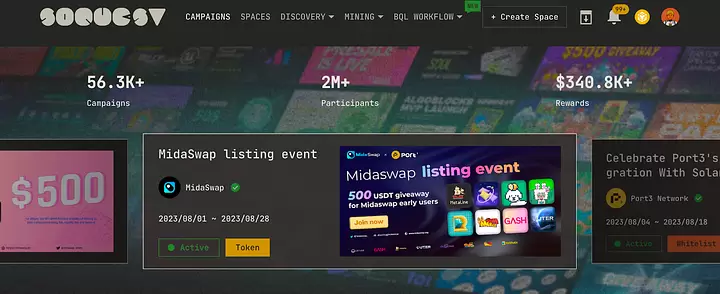
As of now, SoQuest has covered nearly 800,000 users in over 100 countries worldwide. SoQuest supports over 16 public chains and has onboarded over 1800 project parties. Port3 has also launched the SoQuest mobile app, available for Android and iOS systems, for building future user communities and educating new users.
- Mining
Overview:
Total pool: 500 million, with a total of 5 billion gems to be distributed in this mining season.
Effective period: July 1, 2023 - December 31, 2023
Other: SoQuest gems will serve as unique loyalty points, which will be deployed on the blockchain in the future and will be seamlessly connected with SQT (SoQuest gems).
Mode overview:
Quest Mining: 60 million (12%) Broadcast Mining: 10 million (2%) Trade Mining: 400 million (80%) Workflow Mining: 30 million (6%)
Specific information:
1) Quest Mining
1.1 Prize pool:
A total of 60 million gems (including previously distributed gems).
1.2 Mining rules:
Users can participate in "mining tasks" through various activities on SoQuest, including entry activities and FamLive Twitter Space activities. The daily limit for gems obtained through tasks is 200.
1.3 Participation method:
Create users' profiles: Visit SoQuest.xyz, connect users' wallets, and link users' Web2 accounts.
Participate in activities: At SoQuest.xyz/campaign, users can participate in NFT/Token/whitelist tasks, entry activities, and Twitter Spaces to collect gems.

2) Broadcast Mining
2.1 Prize pool:
10 million gems
2.2 Mining rules:
Each valid invitation will be counted, and for each new user who completes SoQuest registration and links their Web2 account, both parties will receive 10 gems.
The inviter will automatically receive 1% of the gems from the invitee's transaction rewards.
Early bird offer:
There are three mining stages, and the earlier users join, the more gems they will win. (For each user, the maximum number of gems that can be mined within 6 months is 35,000 gems)

2.3 Participation method:
Go to the mining page of SoQuest, copy the invitation link to invite friends.
When invited friends log in to SoQuest and link their Web2 account, users are considered to have successfully invited them.
3) Trade Mining
3.1 Prize pool:
400 million gems
3.2 Mining rules:
Users can join SoQuest Swap to receive mining rewards.
Mining rewards will be distributed at 10:00 AM UTC+8 every day.
The distribution of gems is based on the previous day's transaction fees and total transaction volume.
3.3 Participation method:
Visit the trading page on SoQuest.xyz.
Select the source token and target token users want to exchange. Ensure users have enough balance of the source token.
4) Workflow Mining
In SoQuest, workflows are tools for executing transactions on the blockchain through meta-interactions and task flow interactions. Meta-interactions are basic transactions based on the chain, while task flow interactions form a structured workflow to achieve specific goals.
4.1 Prize pool:
30 million gems
4.2 Mining rules:
Users will receive a reward of 10 gems for successfully running the workflow template created by users, and each execution will increase users' cumulative mining output.
Note: Due to its implementation using workflow language, this mining category is more suitable for developers with a certain level of technical proficiency.
4.3 Participation method:
- Create users' BQL templates.
- The SoQuest/Port3 team will review users' templates: If users' templates pass the review, they will be marked as 'verified'.
- Other users can run users' templates. For each successfully run template, users as creators will receive 10 gems.
5) KOL/Project Mining (Currently ended)
In KOL/Project Mining, the mining rewards are directly related to the number of participants in activities created by KOLs or projects. The more participants, the more generous the rewards.
Innovation - QaaS and BQL
In the Quest field, SoQuest continues to innovate, introducing new technologies and services such as QaaS Widget, BQL, in addition to the earlier launch of Web3 task detection.
- QaaS (Quest as a Service)
The Web3 task platform SoQuest has launched the innovative Quest solution Quest-as-a-Service (QaaS). SoQuest QaaS provides a set of Widget plugins that support project parties to seamlessly integrate Quest functionality on any website, allowing users to participate directly in interactions. SoQuest QaaS provides a one-stop task management, reward management, and data analysis tool.
QaaS Widget integrates the capabilities of Quest, such as display, detection, and analysis, into a single Widget that can be embedded into the project's own product web page, achieving seamless integration. Users can view activity status, overall project traffic growth, and conversion effects in the Dashboard, gaining a clear understanding of the funnel chart. With the competition of Quest entering the second half, the openness of QaaS not only reflects its functionality but also deepens the ability to serve Quest, marking the standardization of Quest services. Users are billed through Credits during the use of Quest functionality, enabling usage-based billing.
BQL (Blockchain Quest Language) is a language that automates complex on-chain operations. Written BQL scripts can directly convert users into on-chain users for the project, as users only need to click to run, executing a chain interaction workflow in a single step, which is the ultimate way of Quest.
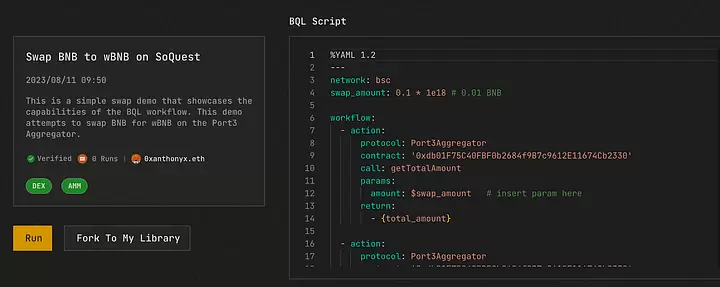
A BQL script for token exchange
BQL (Blockchain Quest Language) is an on-chain interaction language designed to lower the threshold for blockchain interactions, improve efficiency, and free up human resources. It allows users to interact with the blockchain by writing scripts that resemble natural language, which can automatically execute and send transactions to the blockchain.
Key design points of BQL:
- Syntax structure and readability: BQL has a specific syntax structure that aims to be simple, easy to read, and write, reducing user learning costs and operational difficulties.
- Complex process operations: BQL can perform complex process operations, allowing users to design multi-step interaction processes.
- Variable access and program interaction: BQL allows access to variables defined in the program, enabling interaction with the program. It can also interact with users' wallets.
- Execution tracing and event triggering: BQL can trace program execution, defining the combination of each operation based on return values and on-chain status. It includes an event triggering mechanism that can execute operations under specific conditions.
- BQL Workflow design:
BQL Workflow is the workflow corresponding to the BQL script, consisting of multiple interaction steps. Interaction steps can be defined based on return values and on-chain status to execute based on conditions, forming a complete on-chain interaction process.
- BQL use cases:
BQL can be used to execute one-time operations such as Swap, Add Liquidity, and Staking, combining these operations into a complete workflow, simplifying the complexity of blockchain operations.
- BQL as a bridge between humans and the blockchain:
BQL serves as a bridge connecting humans and the blockchain. Its simple syntax allows non-programmers to understand the script's purpose and edit it. It meets the intuitive, non-rigorous natural language description of people, while also being able to execute operations in a rigorous programming language. Through AI, people's ideas can be mapped to BQL Workflow, and through auxiliary means, parameters can be completed, realizing the transition from idea to practice.
- Impact of BQL on on-chain interactions:
The emergence of BQL will change the way on-chain interactions are conducted, moving towards automated programs. However, humans still have the ultimate say, as contracts and assets are still controlled by humans. BQL allows people to focus more on goals and ideas rather than skills, replacing operational rights with programs, but overall operations still adhere to blockchain contracts. In the Web3 field, there may be Web3 AI assistants to help users transform and implement ideas, achieving a higher level of automation.
In the future, the combination of freely accessible Web2 + Web3 on-chain data (related events and data triggers) and BQL on-chain action execution can generate various interaction strategies and processes suitable for project parties to convert users, airdrop interactions, on-chain arbitrage, and various other scenarios. Most importantly, this aligns with the background of the AI era, as it can achieve on-chain closed-loop automation and intelligent control mechanisms, laying the foundation for on-chain AI assistants.
- SoGraph Analysis Platform (Currently only open internally)
The SoGraph Analysis Platform is similar to a combination of Lunarcrush and Nansen, able to track token market trends, market sentiment, KOL and general interactions in social spaces. It mainly combines off-chain data from different Web2 social platforms with various on-chain data, processing it into data indicators, member lists, social/spam volume, and sentiment indicators needed by the market through ML and big data processing algorithms.
This long-term comprehensive data can be used for various application scenarios in the next stage, and diverse data applications and task incentives can attract more users to participate in the construction of the data layer, achieving a virtuous cycle.
3.4 Industry Space and Potential
Port3 Network has successfully launched two practical application projects: Bot Matrix and SoQuest. Currently, the SoQuest platform is rapidly becoming a focus of industry attention. In this analysis, we will focus on the X-to-Earn track involved in these two products and the Quest mode in this field. Next, let's delve into the development of these projects.
- Development trajectory
In summary, the development trajectory of the QUEST platform can be divided into the following stages:
Web2 Marketing Tool Era: Gleam.io, as a marketing tool, cannot meet the requirements of Web3 on-chain tasks, especially in the case of NFT rights being widely used for user acquisition and activation, Gleam has shown limitations.
Large-scale NFT Minting Exploration: Projects such as POAP and Project Galaxy have attempted to build traffic platforms based on large-scale NFT Minting, leading other competitors by more than half a year.
Insight into Web3 Task Detection: In early 2022, SoQuest gained insight into Web3 task detection and built the Quest platform.
Building a Long-term Value Traffic Pool: The Quest platform has built a long-term value traffic pool through open source and deep cultivation strategies, attracting well-known projects from various public chain ecosystems, such as Sui, zkSync, and introducing multiple top projects in the Sui ecosystem such as Cetus, Suiet, Martian.
Unique Profit Model: By reconstructing the Quest experience, accumulating the platform's value, ownership, fun, and social aspects, the Quest platform has created a unique profit model, converting traffic into revenue.
Pursuing Long-term Relationships: The competition of the Quest platform has entered the second half, and it will focus on building long-term relationships. SoQuest is committed to building long-term relationships between projects and users. After users join the community, they should be able to participate in various activities, gradually upgrade, and become an OG from a newbie. Therefore, SoQuest has put more effort into organizing projects' Spaces.
In summary, these are important stages in the development trajectory of the QUEST platform, each presenting unique characteristics and goals, driving the platform forward. So far, SoQuest has accumulated 500,000 registered users in the general traffic pool, covering 7 million community users, who can be reached through robots, completing the first step of traffic accumulation.
3.4.1 Classification
X-to-Earn is a broad classification, referring to a series of projects and platforms based on blockchain technology that aim to allow users to earn cryptocurrency (usually tokens) through various opportunities, such as participating in activities, completing tasks, playing games, or other means.
Projects and platforms in this model can be classified based on their operation mode, target audience, and functional characteristics.
Play-to-Earn:
These projects are typically blockchain-based gaming platforms, where users earn token rewards by participating in games, completing tasks, or selling virtual items.
Work-to-Earn:
These projects allow users to earn tokens by completing specific tasks or providing skills or services. Tasks may include data entry, content creation, design, programming, etc.
Learn-to-Earn:
This type of project encourages users to participate in educational or training activities, learn new skills or knowledge, and earn token rewards by completing courses, participating in discussions, etc.
Trade-to-Earn:
These projects allow users to earn token rewards by participating in cryptocurrency or NFT trading, providing liquidity, or other trading activities.
Social-to-Earn:
These projects enable users to earn token rewards through social interactions such as likes, comments, shares, etc.
NFT-to-Earn:
These projects allow users to earn token rewards or other benefits by purchasing, owning, or trading NFTs.
X-to-Earn is an important track, and Port3 Network can also be classified into this field. Through this project, users can continuously track the activities of relevant projects, learn and complete interactive skills through activities, and obtain corresponding credentials.
● Subdivision of Quest Track
Today, Web3 marketing tools are flourishing. 19 representative projects have been selected from the track and classified into three categories based on the characteristics of the platforms: traffic, education, and segmented verticals. The different classifications are only differences in the entry points of each project. For all these projects, some common indicators are used for comparison to determine their strengths.
Traffic Category
Traffic platforms typically import user traffic for Web3 operators through the form of tasks, aiming to bring early adopters and brand exposure to crypto projects, such as Galxe, SoQuest, TaskOn, etc.
Education Category
Education platforms focus more on enhancing users' awareness of different crypto project products, including guiding users to understand, use products, and achieve educational and growth purposes, such as Layer3, RabbitHole, and Link3.
Segmented Verticals
As Web3 task-based marketing tools, segmented verticals tend to focus on specific areas such as GameFi, DAO, etc., such as Phi Land, Dework, Dequest, Real Player DAO, Carv, etc.
3.4.2 Market Size
The market size of Socialfi is $1.13 billion, with a 24-hour trading volume of $92.48 million and a ranking of 37 on Coingecko. In this vast and diverse market, in-depth analysis will be conducted from three different but related sectors: the largest Socialfi platforms, the Web3 Social & Credentials field, and the Quest track.

Next, focusing on the Web3 Social & Credentials field, the total number of users has reached around 5.47 million, with nearly 83% of the protocol users being independent addresses. According to incomplete statistics from Dune in this track, Galxe has the highest market share at 41%, Cyberconnect at 25%, and POAP at 22%. The top three projects almost occupy 90% of the market share, especially Galxe, which has shown a dominant effect.
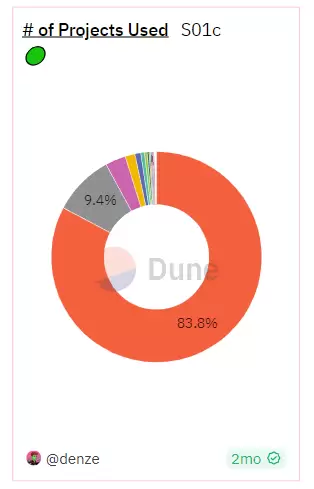



Basic data statistics from the project side show that the Web3 marketing growth tool track started to emerge in 2021 and began to enter a period of explosive development in 2022. Except for the old Web3 task platforms led by Galxe, which entered the market in 2021, the rest were mostly launched in 2022, making this track a short-term early development track.
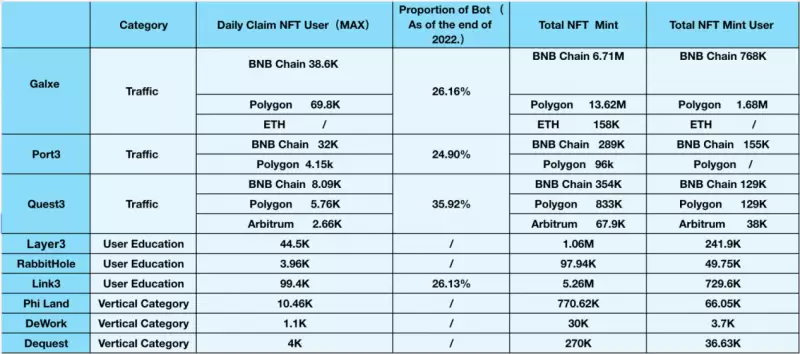
The data indicates significant differences in user traffic among platforms. In the early market, Galxe, with its first-mover advantage and multi-chain layout, stands out and takes the lead. In comparison, other projects belong to the second tier. This highlights the crucial role of the first-mover advantage in capturing the market in the Web3 field, laying the foundation for future competition.
From segmented fields to the overall sector, they collectively outline the diverse landscape of the Socialfi market. The largest Socialfi platforms, the Web3 Social & Credentials field, and the Quest track together form a thriving social finance ecosystem in the Web3 world.
3.5 Business Data
● Operational Data
Overall Overview
As of now, according to official data, Port3 Network has over 534,000 registered users, has hosted over 74,600 published events, and has collaborated with over 2,200 partners. With continuous product version updates, over 125 new versions have been released. Port3 Network's extensive collaboration network and continuously innovative product versions demonstrate a strong trend of user growth.
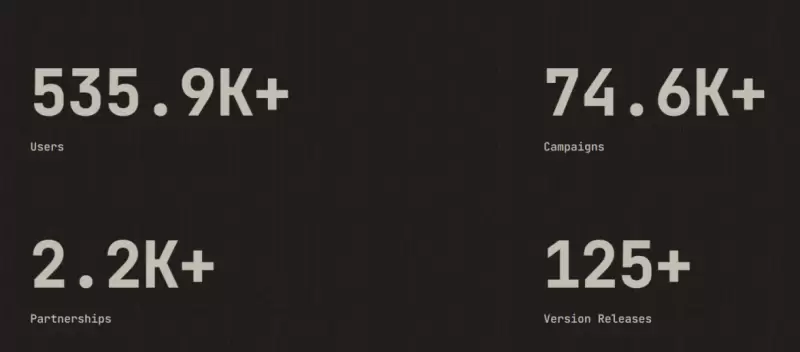
On-chain Data
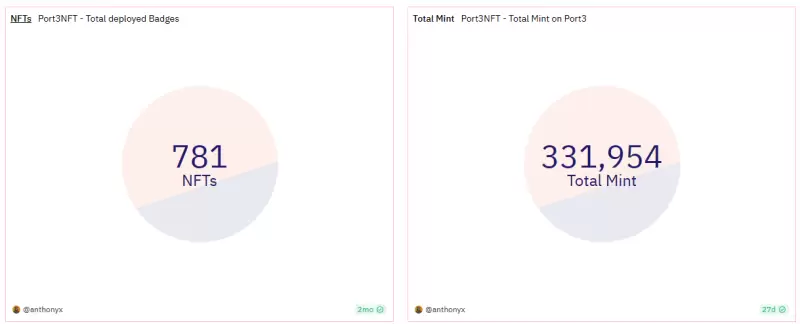
BNB Chain

Polygon Chain

BNB Chain

Polygon Chain
According to Dune's data, as of September 19, 2023, a total of 331,900 NFTs have been minted on the BNB chain, earning 781 badges. On the Polygon chain, a total of 109,000 NFTs have been minted, and 627 events have been held. Observing the daily active users on both chains, it can be observed that users were more inclined to mint NFTs on the Polygon chain when the project was first launched. After some time, the number of users on the BNB chain gradually increased, possibly due to more recent events being held on the BNB chain.
● SoQuest Mining Data
Overall Overview: (as of 2023.9.19)
Total Pool: 500 Million, 19.32 Million, 3.86% of the total pool has been mined
Quest Mining: 60 Million (12% of the total), 89.72% of the 60 Million has been mined
Broadcast Mining: 10 Million (2% of the total), 1.71% of the 10 Million has been mined
Trade Mining: 400 Million (80% of the total), 8.46% of the 400 Million has been mined
Workflow Mining: 30 Million (6% of the total), 0.11% of the 30 Million has been mined
Overall, Quest Mining has the highest participation activity, followed by Trading and Broadcast, with Workflow being the least active.


Mining Participation:
Quest Mining: Currently online for 256 days, with 189.41K participants
Broadcast Mining: Currently online for 256 days, with 17.53K participants
Trade Mining: Currently online for 57 days, with 2517 participants
Workflow Mining: Currently online for 40 days, with 4 participants

Quest Mining

Broadcast Mining

Trade Mining

Workflow Mining
Currently, the cumulative mining quantity of the top ten mining addresses exceeds 30,000. The top address has a cumulative mining quantity of over 320,000, which is 5 to 6 times more than the second place, showing a significant advantage in mining for some addresses.
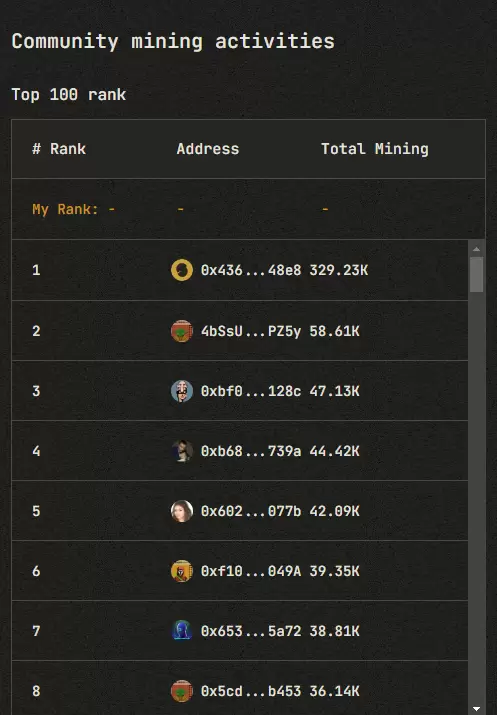
● Social Media Data
Twitter: 208,000 followers
Discord: 104,000 followers, with a daily active user count of over 3000 (The Discord channel considers the language needs of different nationalities and has multiple language sections, in line with the characteristics of social platforms. The Discord community is highly active, with most discussions related to quest tasks.)
Telegram: 26,400 followers
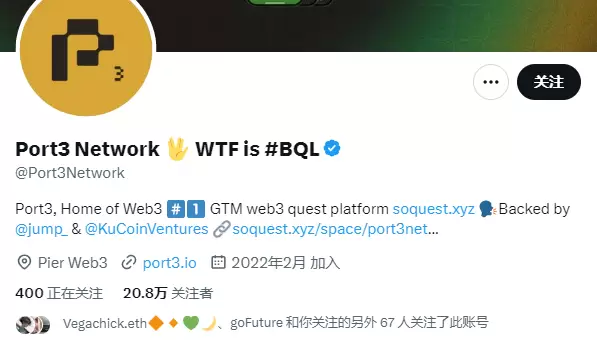
3.6 Project Competitive Landscape
Considering that this project involves multiple products, from a data perspective, it may be more inclined to compare with similar competing projects such as ARKHAM. On the other hand, if Bot Matrix is used as the entry point, it may be more suitable to compare with projects in the TG track. However, the currently implemented and widely used product is SoQuest. Therefore, when comparing projects, the focus will be on SoQuest to gain a deeper understanding of its unique position and impact in the Web3 ecosystem.
3.6.1 Project Introductions
Galxe
Galxe is a Web3 credential data (DID) network. In terms of project planning, Galxe is built on an open and collaborative infrastructure to help Web3 developers and projects utilize digital credential data and NFTs to build better products and communities. For on-chain credentials, curators can provide subgraph queries or static snapshots. For off-chain credentials, the project has integrated with data sources such as Snapshot.org, Twitter, and Github. By contributing to Galxe's credential data network, curators will be rewarded when credentials are used in Galxe's application modules, credential ORACLE engine, and credential API.
QuestN
QuestN is a social task platform that primarily drives Web3 growth and user engagement. Users can earn cryptocurrency by completing tasks and participating in advertisements. The platform integrates marketing, growth, and analytics, providing support for effective user acquisition. Advertisers can utilize permissionless on-chain/off-chain tasks as attention-grabbing ad formats and incentivize user participation through tokens, NFTs, whitelists, and Discord roles. Users participating in tasks can accumulate rewards, enhance community reputation, and unlock more social tasks.
3.6.2 Project Comparison
● Simple Comparison
Overall comparison of different projects in the same track.
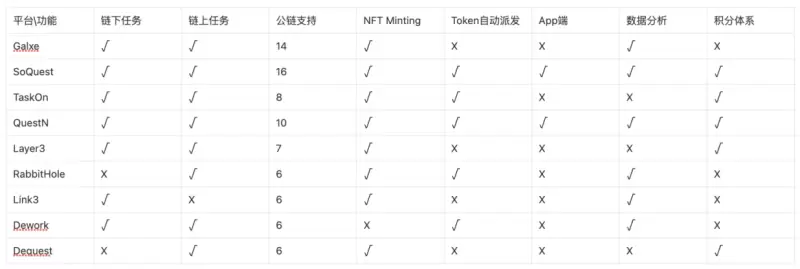
Comparison of Mainstream Functions and Public Chain Support on Various Platforms
Advantages of the QuestN Project:
- Product Features: QuestN is characterized by simplicity and speed, allowing users to create and publish tasks within three minutes.
- No Threshold Restrictions: QuestN is a completely permissionless task platform with no threshold restrictions, allowing anyone to publish tasks on the platform.
- Efficient Task Publishing and User-Friendly Experience: QuestN has gained popularity among B-side user groups in a short period of time, with its efficient task publishing and user-friendly experience being well recognized.
Disadvantages of the QuestN Project:
- Currently in the emerging stage, with a relatively low market share.
- Currently only provides task platform services, lacking a diversified product line.
Advantages of the Galxe Project:
- Strong Background: Galxe is one of the largest data network platforms in the Web3 world, and its token Gal was first listed on major exchanges such as Binance, Kraken, Coinbase, and OKX.
- Leading Market Share: Currently, Galxe holds a large market share and ranks first, with the highest number of users, demonstrating a clear first-mover advantage.
- Promising Development Prospects: Despite recent price declines, Galxe still has broad development prospects and has laid a solid foundation for future growth.
Disadvantages of the Galxe Project:
- Unlike QuestN, Galxe is more of a token project rather than a product project, and its value and market performance are influenced by the cryptocurrency market.
- Compared to QuestN, Galxe has a relatively single product line, lacking diversification.
3.7 Token Model Analysis
Total Token Supply and Distribution
Currently, the project team has not yet established a token economic model, but the Port3 Network team in the community has indicated that they plan to launch the token in Q4 of this year at the latest in Q1 of next year. The team has stated that they will wait for market conditions and do not want to launch prematurely to the detriment of user interests.

4. Preliminary Valuation
4.1 Core Issues
Does the project have a reliable competitive advantage? Where does this competitive advantage come from?
The competitive advantage of Port3 can be summarized in the following two aspects:
1) Data Integration Advantage: Port3 can effectively bridge the gap between data and DApps in the Web3 ecosystem by creating a social data layer that is accessible and powerful for all Web3 use cases through the aggregation and standardization of off-chain and on-chain data protocols. This advantage belongs to the competitive advantage of data infrastructure.
2) Community Building Advantage: Port3's key product, SoQuest, is described as one of the most popular Web3 Quest platforms, which can help projects build Web3 communities and aggregate various project activities and information. By attracting user participation through organizing events and providing rewards, it provides tools and platforms to support Web3 community participation and development. This advantage belongs to the competitive advantage of community building and user participation.
Overall, Port3's competitive advantage comes from its focus on social data infrastructure and its ability to provide tools and platforms to support the development and participation of the Web3 community.
What are the main variable factors in the operation of the project? Are these factors easy to quantify and measure?
1) User Engagement: Including user activity, community participation, task participation, etc. This can be quantified and measured through user activity statistics, social interaction data, task completion rates, etc.
2) Task Innovation and Diversity: The number, diversity, and innovation of different types of tasks can attract more user participation. This can be measured through task categorization, the speed of introducing new tasks, etc.
3) Community Size and Growth Rate: The number and growth rate of community members are important factors in the project's development and are indicators of the project's popularity. This can be measured through community member registrations, community activity, etc.
4) Marketing Effectiveness: The impact of marketing and promotional activities on attracting users and increasing visibility. This can be measured through the return on investment of marketing activities, social media attention, ad click-through rates, etc.
5) Partnerships: Collaborations with other projects, platforms, or institutions can enhance the project's influence and user participation. This can be measured through the number of collaborative projects, the results of collaborations, etc.
6) Technological Upgrades and Innovations: Continuous technological upgrades and innovations can maintain the project's competitiveness and attractiveness. This can be measured through the frequency of technological updates, the introduction of new features, etc.
Most of these factors can be quantified and measured, especially those related to user activity, social interaction, and marketing. These variables can be quantified and evaluated through data statistics, user feedback, market analysis, etc.
4.2 Major Risks
Strong Competitors: In the social task platform, leading platforms such as Galxe have already captured a large market share. Competing with these platforms requires overcoming significant competitive pressures, including challenges in user stickiness, brand awareness, and community size.
Data Security and Privacy Risks: As a combination of the underlying and application layers of SocialFi's social applications, the project will handle a large amount of user data, including sensitive information. Therefore, ensuring data security and privacy protection is a serious challenge. Any data leaks, security vulnerabilities, or hacker attacks could seriously affect user trust and the project's reputation.
Product Launch Risks: For the two products that have not yet been launched, there may be risks such as low user acceptance, product functionality not meeting expectations, and poor market response after launch. Ensuring that the products can iterate quickly and meet user needs is crucial.
5. References
- https://Port3.io/ Official website
- https://medium.com/@Port3/Port3-Network-Web3-%E7%9A%84-%E5%8E%BB%E4%B8%AD%E5%BF%83%E5%8C%96%E7%A4%BE%E4%BA%A4%E6%95%B0%E6%8D%AE%E5%B1%82-f6c456556f44 Official business description
- https://www.rootdata.com/zh/member/Anthony%20Deng?k=MTQxODc%3D Rootdata official website
- https://www.linkedin.com/company/Port3-Network/ Port3 LinkedIn
- https://Galxe.com/protocol Galxe
- https://questn.com/ QuestN official website
- https://foresightnews.pro/article/detail/37681 SoQuest BQL - AI Era On-Chain Interaction Language
- https://foresightnews.pro/article/detail/33791 Understanding the Development and Final Battle of Web3 Task Marketing Tools
- https://dune.com/denze/Web3-social Dune data panel
免责声明:本文章仅代表作者个人观点,不代表本平台的立场和观点。本文章仅供信息分享,不构成对任何人的任何投资建议。用户与作者之间的任何争议,与本平台无关。如网页中刊载的文章或图片涉及侵权,请提供相关的权利证明和身份证明发送邮件到support@aicoin.com,本平台相关工作人员将会进行核查。




